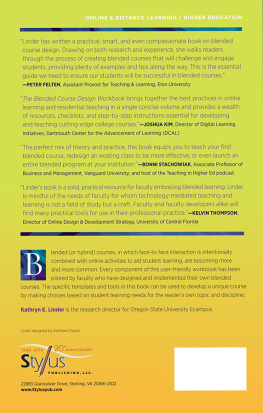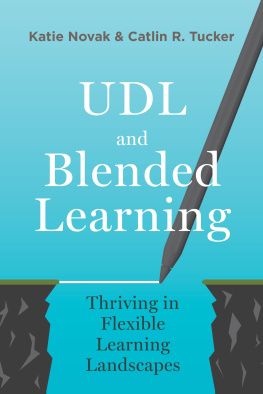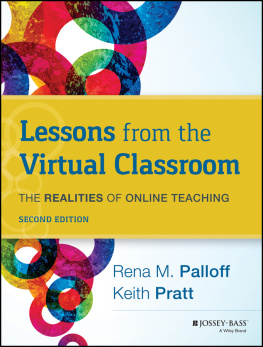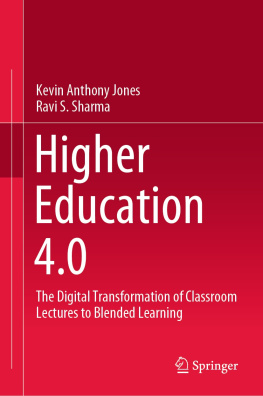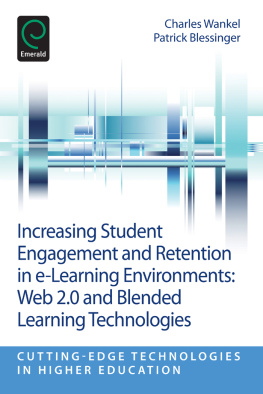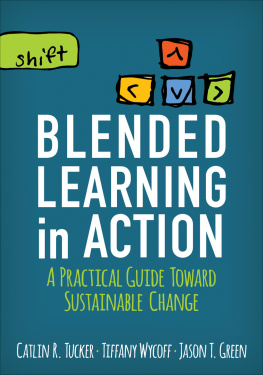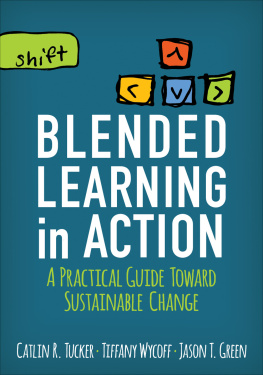Teaching in Blended Learning Environments
Issues in Distance Education
Series Editors: Terry Anderson and David Wiley
Distance education is the fastest-growing mode of formal and informal teaching, training, and learning. Its many variants include e-learning, mobile learning, and immersive learning environments. The series presents recent research results and offers informative and accessible overviews, analyses, and explorations of current issues and the technologies and services used in distance education. Each volume focuses on critical questions and emerging trends, while also taking note of the evolutionary history and roots of this specialized mode of education and training. The series is aimed at a wide group of readers including distance education teachers, trainers, administrators, researchers, and students.
SERIES TITLES
Theory and Practice of Online Learning, second edition
edited by Terry Anderson
Mobile Learning: Transforming the Delivery of Education and Training
edited by Mohamed Ally
A Designers Log: Case Studies in Instructional Design
by Michael Power
Accessible Elements: Teaching Science Online and at a Distance
edited by Dietmar Kennepohl and Lawton Shaw
Emerging Technologies in Distance Education
edited by George Veletsianos
Flexible Pedagogy, Flexible Practice:
Notes from the Trenches of Distance Education
edited by Elizabeth Burge, Chre Campbell Gibson, and Terry Gibson
Teaching in Blended Learning Environments:
Creating and Sustaining Communities of Inquiry
by Norman D. Vaughan, Martha Cleveland-Innes and D. Randy Garrison
TEACHING IN BLENDED LEARNING ENVIRONMENTS
C REATING AND S USTAINING C OMMUNITIES OF I NQUIRY
Norman D. Vaughan
Martha Cleveland-Innes
and
D. Randy Garrison
Copyright 2013 Norman D. Vaughan, Martha Cleveland-Innes, and D. Randy Garrison
Published by AU Press, Athabasca University
1200, 10011 109 Street, Edmonton, AB T5J 3S6
ISBN 978-1-927356-47-0 (print) 978-1-927356-48-7 ( PDF )
978-1-927356-49-4 (epub)
Cover and interior design by Sergiy Kozakov.
Printed and bound in Canada by Marquis Book Printers.
Library and Archives Canada Cataloguing in Publication
Vaughan, Norman D., 1960
Teaching in blended learning environments : creating and sustaining communities of inquiry / Norman D. Vaughan, Martha Cleveland-Innes, and D. Randy Garrison
(Issues in distance education series)
Includes bibliographical references and index.
Issued also in electronic formats.
ISBN 978-1-927356-47-0
1. Education, HigherComputer-assisted instruction. 2. TeachingComputer network resources. 3. Blended learning. 4. Internet in higher education. I. Cleveland-Innes, M. II. Garrison, D. R. (Donn Randy) III. Title. IV. Series: Issues in distance education series.
LB2395.7.V39 2013 371.3 C2013-901785-2
We acknowledge the financial support of the Government of Canada through the Canada Book Fund ( CBF ) for our publishing activities.
Assistance provided by the Government of Alberta, Alberta Multimedia Development Fund.
Please contact AU Press, Athabasca University at for permissions and copyright information.
List of Tables
List of Figures
)
This book is dedicated to our families
who supported our work on this text.
Preface
The focus of this book is the teaching practices required of blended learning approaches and designs in higher education. Our previous book, Blended Learning in Higher Education (Garrison & Vaughan, 2008), in which we defined blended learning as the organic integration of thoughtfully selected and complementary face-to-face and online approaches and technologies (p. 148) guides us in this goal. Feedback from the publication of this first book indicated that the unique feature of this work was the provision of a coherent framework in which to explore the transformative concept of blended learning. Invariably, as we made presentations and conducted work-shops, the consistent message we received was about how valuable the rationale is to understanding the purpose and practical challenges of adopting blended learning approaches in higher education. In Teaching in Blended Learning Environments: Creating and Sustaining Communities of Inquiry, we build upon the framework and concepts of our previous work.
The context of this book is the growing demand for improved teaching in higher education. Traditionally, faculty members served as content experts, selecting disciplinary content to be transmitted to students largely through lectures. Unfortunately, most faculty members do so with limited knowledge of pedagogy and appreciation of the value and growing importance of engagement in a community of inquiry. This book provides a coherent and comprehensive practical view of teaching in higher education that provides a map of the future in terms of integrating face-to-face and online learning.
Our focus here is on teaching as it relates to the design, facilitation, direction, and assessment of blended learning in contemporary higher education. The transformative innovation of virtual communication and online learning communities creates new ways for teachers and students to engage, interact, and contribute to learning. This new learning environment, when combined with face-to-face interactions, will necessitate significant role adjustments and the need to understand the concept of teaching presence for deep and meaningful learning outcomes. This book defines teaching presence as the effort and activity around the design, facilitation, and direction of cognitive and social processes in learning communities for the purpose of realizing personally meaningful and educationally worthwhile learning.
Introducing a phenomenon as complex as teaching presence in a blended learning context is a daunting task. Beyond discussing teaching with technology, writing this book was a process of explicating, examining, and describing a very different approach to higher education an approach that represents the era of blended learning. We see that neither the purpose, the methods, nor the population for whom education is intended today, bear any resemblance to those on which formal education is historically based (Pond, 2002, n.p.). These changes include a new way of conceiving of, and offering, teaching and learning. The need for, and purpose of, this book lies in the fact that the context, the technology, and the students that are part of contemporary higher education are different, and those differences must be accommodated in the teaching practices of our institutions (Dziuban et al., 2010).
To make these changes relevant and real, the book focuses on the practice of teaching in blended learning environments. In addition to addressing new approaches to teaching and learning in higher education, two central ideas come together. First, information and communications technology provide the opportunity to create communities of learners that support engagement and collaboration. The online Community of Inquiry theoretical framework introduced by Garrison, Anderson, and Archer (2000) guides this idea. The reason their framework is valuable for this task is the active presence of a teacher at its core, working toward active cognitive and social presence of all the participants. Distinguished from the lecturer transmitting accepted knowledge in traditional face-to-face teaching (sage on the stage), or the role of instructor in traditional distance education (guide on the side), the teacher in a blended environment is collaboratively present in designing, facilitating, and directing the educational experience.
Next page

